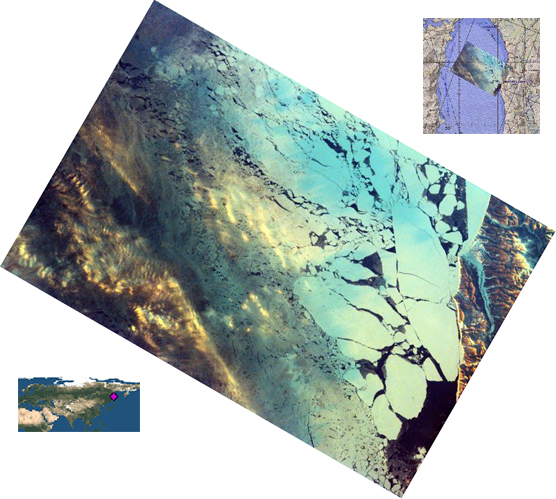Favorite Image: STS099.ESC.07133952
Sakhalin Island, Russia
Sakhalin Island is located just north of Japan and east of the Khabarovski and Primorski Krai of the Russian Far East. Together with the Kuril Islands, it forms Sakhalin Province. The island is long and narrow, almost 589 miles in length. It is 100 miles wide and covers an area of 29,500 square miles. The climate ranges from temperate on the south end to tundra on the north. Sakhalin is rich in natural resources, with substantial timber, fishing, and oil reserves. The island has mountainous terrain on both its east and west coasts, with a long central valley between. The Strait of Tartar, defined by the warm Japanese current flowing from the south, separates the west coast of Sakhalin Island from mainland Russia. The Sea of Okhotsk to the east is cold and freezes solid during the winter. The temperature differences in the water create a climate of wind, rain, and fog, with substantial snowfall during winter. The southern coasts of Sakhalin were first settled by Japanese fishermen. Sakhalin Island was used by Russia as a penal colony in the late 19th and early 20th centuries. Being sent to Sakhalin was considered worse than being sent to Siberia. Permanent agricultural settlements on Sakhalin took in men who had finished serving their time, exiled settlers, and members of families who voluntarily followed prisoners to Sakhalin.
Vegetation on the island ranges from tundra and stunted forests of birch and willow in the north to dense deciduous forest in the south. Fishing, mainly for crab, herring, cod, and salmon, is the principal economic activity around the coast. Petroleum and natural gas extraction flourish in the north, while coal mining and lumbering, including paper production, form the basis of the rest of the economy. The main agricultural activity is raising livestock.
Vegetation on the island ranges from tundra and stunted forests of birch and willow in the north to dense deciduous forest in the south. Fishing, mainly for crab, herring, cod, and salmon, is the principal economic activity around the coast. Petroleum and natural gas extraction flourish in the north, while coal mining and lumbering, including paper production, form the basis of the rest of the economy. The main agricultural activity is raising livestock.








